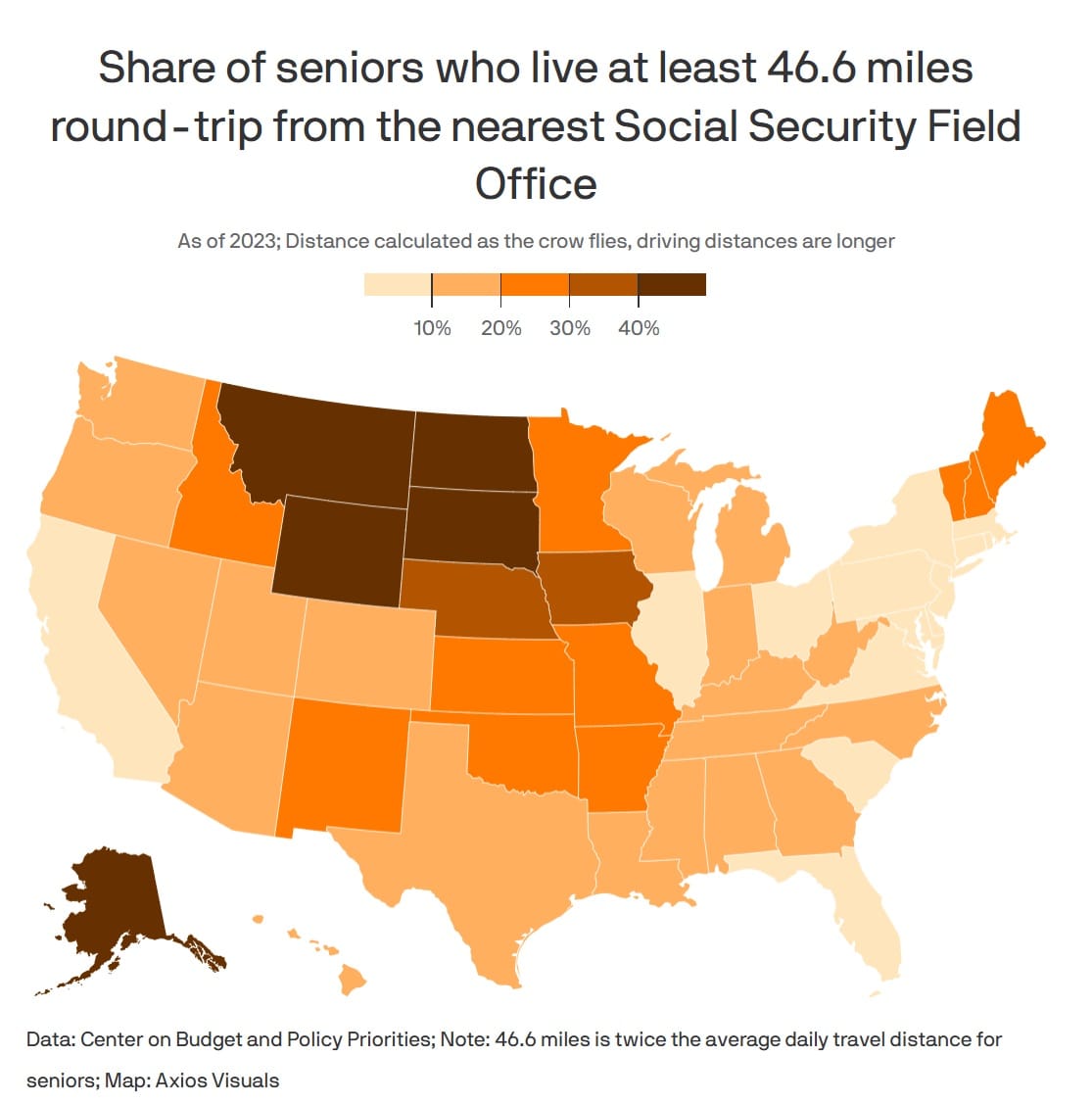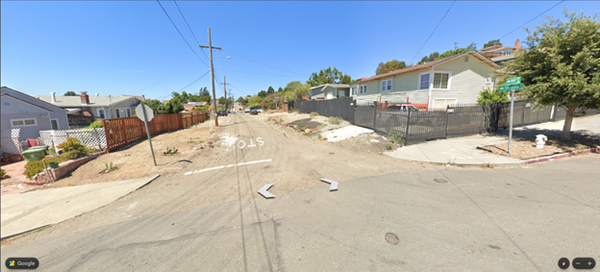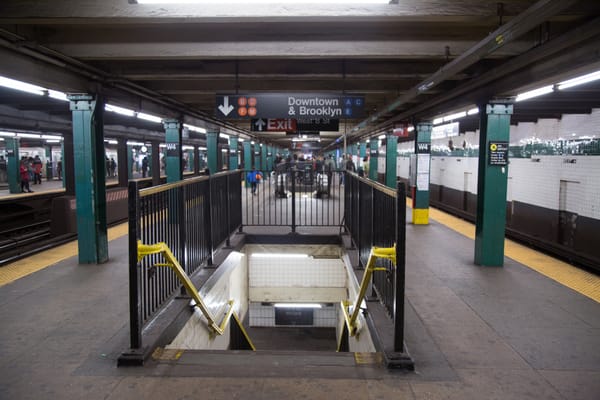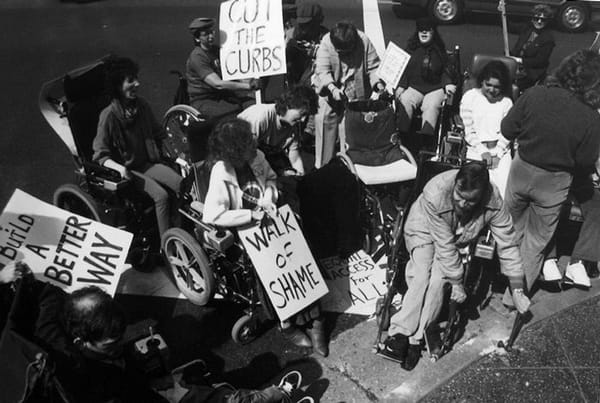Trump 2.0 is a Disability Catastrophe (and it's Bad for Urbanism, too)

Apologies for the Gap between Posts (again)
For most of this year, a pressure sore has forced me to spend about half the time that I'm in my chair just full-on tilted back like I’m at the dentist. That limited how many hours I could use my PC, and I’ve had to prioritize non-DisabilitYIMBY stuff with that time since January (thus, the gap between posts). Luckily, a combination of accommodations – a new monitor mount and desk layout, plus installing KnowBrainer (an add-on software that supercharges Dragon NaturallySpeaking and makes hands-free operation much easier) – has gotten me closer to full speed again. Thanks Be for the desk help and Zina for the KnowBrainer recommendation. You’re lifesavers.
Paying subscribers – let me know here if you'd like a refund for these missing months.
A Whole New Regime
Obviously, the past few months have been transformational for how our government and society operate. The Trump Administration is shredding alliances, tanking the economy, destroying government agencies as we know them, ignoring human rights, and generally acting in lawless, unconstitutional and chaotic ways. The new regime has been awful for almost everything disability, climate, and urban development – and we aren’t even three months in.
People with disabilities (PWDs) are right in the crosshairs of the Administration and its allies in Congress. Federal reorganization and staffing cuts – inspired by Project 2025 and spearheaded by Elon Musk’s DOGE – are hitting critical disability programs, especially in the Social Security Administration (SSA) and Department of Health and Human Services (HHS).
The Washington Post reports that the administration has “moved ahead with dramatic cuts to staffing and closures of offices” at SSA, which has cratered customer service for the seniors, people with disabilities, and survivors that receive benefits. SSA has lost 7000 jobs since February from early retirements, buyouts, resignations and firings, and the Post reports that DOGE is demanding a further reduction in force (RIF):
The DOGE team did not provide a specific number of jobs that must be eliminated, officials said, but asked for staff reductions to broad areas of operation, including communications, personnel, legislative and congressional affairs, retirement and disability policy, and other “support components.” Also on the list is the information technology department of about 4,000 employees, which is confronting a flurry of website crashes that has shut out customers from accessing their benefit information. Up to 800 people could be laid off in that department, according to one senior official.
There’s a land use component to this, too. The Center on Budget and Policy Priorities estimates that nearly 6 million seniors live more than 23.3 miles as the crow flies from an SSA field office (so the numbers would be much higher for 23.3 miles driven) – and, as expected, rural areas are the worst off. The analysis shows that 46% of Alaska seniors live more than 23.3 miles from an office and that in North Dakota, a full 13,000 seniors live more than 90 miles from an office. It just so happens that those are the kinds of places SSA field offices are set to close. The Post notes that “dozens of field offices from Clinton, South Carolina, to San Antonio will lose more than a quarter of their staffs, according to recent data published on the Social Security website… [m]any of these offices are in rural areas, with the Social Security office as far as 100 miles away in some places.” Ultimately, the DOGE-ification of SSA will hit rural seniors and PWDs hardest.

… To top it off, DOGE just might blow up the whole Social Security system when they try to rebuild the SSA code base “in months” instead of the years it would take to do so safely. (I hate to even think of those worst-case scenarios, but at this point it's better to stay informed even if that means knowing that DOGE's recent college grads are recklessly reprogramming the nation's retirement fund).
The Disability Rights Education and Defense Fund (DREDF) notes that the ongoing re-organization of HHS will jeopardize disabled folks’ independence, especially when it comes to long-term support services (LTSS) that are coordinated between divisions:
HHS’s announcement that it is cutting 28 divisions to fifteen, laying off 20,000 workers, and closing half of its ten regional offices may sound efficient at first, but in practice, it means that more people will not get the services they need when it counts. People with disabilities may be discharged without local housing to go to, they may lack needed equipment or accessible features if they have a home to go to, and they may face daily gaps in personal care assistance or food because coordinating agreements aren’t entered and payments aren’t timely made. These things happen now because LTSS coordination is hard. And the problems will happen more with this restructuring. And the proposed centralization in all of HHS of “Human Resources, Information Technology, Procurement, External Affairs, and Policy” means that people with disabilities and disability advocates will probably not even have these negative changes tracked or the data to argue for more resources and attention.
HHS head RFK Jr. is dissolving the Administration for Community Living (ACL) – which funds and coordinates services and supports for seniors and people with disabilities and makes “investments in research, education, and innovation” – and is planning to have its roles handled by multiple other agencies within HHS. Alison Barkoff, who was ACL’s acting administrator and assistant secretary for aging for most of the Biden administration, told Mother Jones that “the real concern is that if ACL and its programs are spread across the [HHS] department, we will see more people forced into institutional settings, out of their own homes, out of their own communities.”
In an ode to eugenics, RFK Jr. is in the process of decimating medical research that helps improve health outcomes and quality of life for disabled folks. The conspiratorial HHS Secretary has been deeply involved in anti-vax and wellness movements for decades – both of which frame chronic health and disability badly (for example, treating autism as an “epidemic” to be eliminated through the elimination of vaccines, instead of a disability to be accepted and accommodated). In their March 8 episode, Derek Beres and Matt Remski of the Conspirituality Podcast used the term “soft eugenics” to describe the Make America Healthy Again (MAHA) movement that RFK Jr. leads. David Gorski summarizes it this way: “[i]nstead of an active removal of the ‘unfit’ from the gene pool, ‘soft eugenics’ is more of a shrug, followed by an attitude of ‘let nature take its course.’” So now, soft eugenicists oversee the Department that most directly addresses the health and well-being of people with disabilities, and they shrug about the life-or-death stakes of canceled cancer treatment (among other casualties of HHS cuts). It’s a harmful situation as-is – and the slippery slope of soft eugenics is something to fight.
Congress is doing its part to harm PWDs by pursuing massive cuts to Medicaid and SNAP. Rural areas are poised to be hit especially hard, just as with Social Security. Farmers Advance highlights the disproportionate impact, noting that “18.3 percent of all adults between age 19 and 64 who live in the rural U.S. are on Medicaid while that number for ‘metro’ adults is a lower 16.3 percent,” and “[t]he numbers are worse if you examine the impact Medicaid cuts will have on rural nursing homes, already fighting to survive due mostly to lack of state and federal funding, difficulty in finding qualified employees in fast-emptying, fast-aging rural counties and continually rising health care costs.” Disability advocates have pointed out that home and community-based services (HCBS), which allow PWDs to live in their own homes instead of institutions, may ultimately get cut by states even if it violates the Olmstead v. L.C. decision that cemented our right to independent living.
On the YIMBY side of things, the administration has gone after funding for homes and other types of shelter. Fresh cuts are often tied to the MAGA crusade against diversity, equity, inclusion, and accessibility (DEIA) and even their xenophobia. For example, in late February the Department of Housing and Urban Development (HUD) froze $30 million intended for fair housing organizations as part of its anti-DEIA push; last month, in a win for the nonprofits, a federal judge ordered HUD to unfreeze and distribute the money. The administration also recently canceled $188 million in grants to New York City that were used to shelter migrants, with the “justification” that the money supported illegal immigration.
Sustainability and resilience efforts are taking a direct hit as the administration tries to eliminate everything that mentions climate change from the federal government. For example, the Building Resilient Infrastructure and Communities (BRIC) program run by the Federal Emergency Management Agency (FEMA) has been nixed, with the administration pausing distributions for already-awarded grants. BRIC was allotted $1 billion under the Infrastructure Investment and Jobs Act, but only $133 million has been handed out so far, meaning Trump is canceling over $800 million in climate resilience efforts nationwide. But that’s a small chunk of the FEMA problems: top officials have said they will outright eliminate the agency and let states take the lead on disaster response, and the agency is in turmoil with so much uncertainty about its future. PWDs are disproportionately harmed in disasters and have fewer resources to recover compared to their able-bodied brethren, so the destruction of FEMA is a direct attack on the disability community.
At a higher level, the economic harm from Trump’s tariffs and destruction of federal agencies will hit disabled people hardest. Tariffs are regressive, and Trump’s end-game dream of replacing income taxes with tariffs alone would be “a highly regressive and inequitable reversion in public policy,” according to PPI. In aggregate, PWDs will be hit by tariffs harder than able-bodied folks just by virtue of being lower income, and many PWDs will face higher costs and shortages of medical supplies and medications (which, unlike phones, are not exempt from Trump’s tariffs). When it comes to the larger economy, PWDs already have an unemployment rate that’s almost double that of people without disabilities, and disabled unemployment reached a high of 16.9% during the Great Recession compared to 10.4% for non-disabled folks. PWDs are too often “first to be fired, last to be hired” and a crashing economy will be especially harsh to disabled workers. A recession will also lead to austerity at the federal, state, and local levels, with all the harm that means for PWDs.
So, yeah. Not a great three months so far, and not looking so hot for the future...
Looking Forward
Government systems were built up over decades to support independent living and guarantee civil rights, but now those are partly collapsed and entirely at risk. There are also foreseeable tipping points that could endanger the well-being, independence, and survival of countless PWDs. Maybe DOGE will break Social Security’s payment system in a failed code base switch; maybe the GOP’s Medicaid cuts will kill states’ HCBS programs and leave thousands without government-funded care attendants; maybe all this political instability descends into violence, and PWDs face either the eugenicist boot of fascism or disproportionate risk as civilians in civil war (or maybe both).
I don’t know exactly what the game plan needs to be, but we are facing unprecedented times and need new strategies. Someone I know from inclusive disaster management is imploring disability leaders to move away from traditional political activism and toward mutual aid networks for community survival, and I’m at least partly on board with that. Whatever traditional activism does exist needs to be strategic and forward-looking, focused on winnable fights, and centered largely around state and local politics.
Two things that will be critical are a) building community among PWDs, our friends, our allies, and our existing support networks and b) talking honestly about what surviving a world with fewer services and more oppression will look like. So, I encourage you to shore up and expand your networks. Disabled folks can take a lead in their own community, organizing discussion events and sharing resilience strategies. Able-bodied people ("ABs") can take this opportunity to strengthen their own disability community, whether that's through family, friends, or volunteering at the local disability nonprofit. And eventually we'll all need to move away from conversation and toward action, building concrete resilience in the face of so much uncertainty.
Take care of yourselves out there (and take care of each other).
In Other News
So, that was a roundup of the past three months. Here are some other links from the past few weeks:
The Climate Crisis Hits Tenants Hardest. They’re Fighting Back - Shelterforce
The Eaton Fire Hit Caltech Scientists Close to Home. Now, They’re Studying the Toxic Aftermath - KQED
In 15 Years, 80,000 Homes in the New York Area May Be Lost to Flooding - New York Times
New fire maps put nearly 4 million Californians in hazardous zones. What does that mean for the people who live there? - CalMatters
Global Disability Summit Concludes With Commitments For Inclusion - MENAFN
Private Equity's Growing Role in Disability Care Demands Urgent Oversight - Medpage Today/MSN
Funding shortfall threatens future of Arizona disability program - AZFamily
Will this bill be the end of California’s housing vs environment wars? - CalMatters
Study finds LA would have more affordable housing if ‘mansion tax’ did not apply to new apartments - LAist
Angelenos in unstable housing more likely to shelter wildfire evacuees, according to survey - LAist




